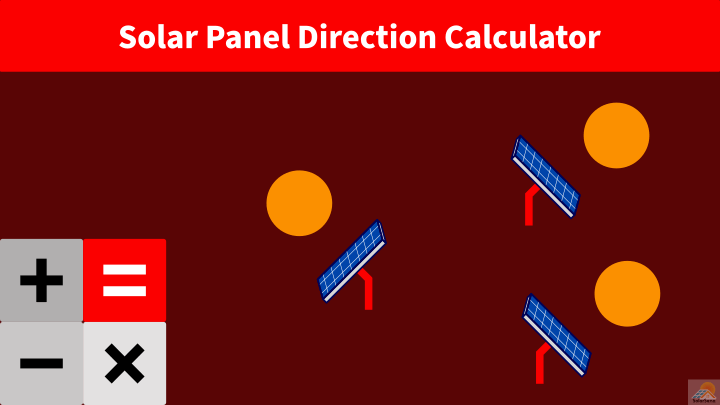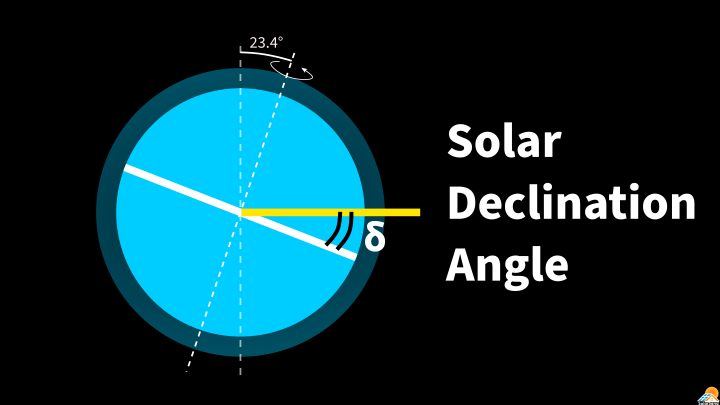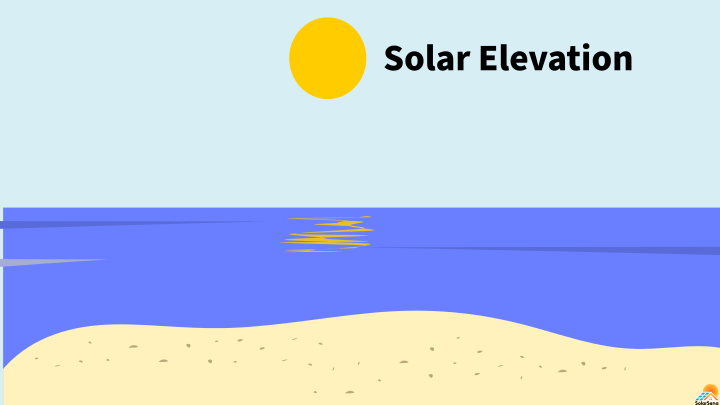Select your timezone and enter your coordinates (latitude and longitude) to calculate the best direction for fixed solar panels, twice adjusted solar panels, quarterly (seasonally) adjusted solar panels, and monthly adjusted solar panels.
You can find your coordinates from Google Search.
The calculator gives the optimal directions for all four possible scenarios (fixed, twice adjustable, seasonally adjustable, and monthly adjustable). And they are displayed in the following four tables.
| Months | Optimal direction |
|---|---|
| Entire year |
| Months | Optimal direction |
|---|---|
| March to August | |
| September to February |
| Months | Optimal direction | Northern hemisphere | Southern hemisphere |
|---|---|---|---|
| March to May | Spring | Fall | |
| June to August | Summer | Winter | |
| September to November | Fall | Spring | |
| December to February | Winter | Summer |
| Months | Optimal direction |
|---|---|
| January | |
| February | |
| March | |
| April | |
| May | |
| June | |
| July | |
| August | |
| September | |
| October | |
| November | |
| December |
What is the optimal direction for solar panels?
Solar panels produce electricity when sunlight strikes the surface of PV panels. This energy is what we called solar power. To produce maximum solar power, solar panels must always face the sun. However, it is not as easy as it looks. The position of the sun in the sky is not static. It changes every hour and every month. It is difficult for us to track the sun in the sky without solar trackers. Manually, we cannot always face our panel facing the sun.
The sun will be in the east in the morning, west in the evening, and somewhere in the middle of the sky in the afternoon. So, what direction should we face solar panels? That is where the notion of the optimal direction comes in.
The optimal direction is the most favorable direction such that solar panels will be able to produce power in the morning, in the evening, and in the afternoon. Optimal direction accounts for both hourly as well as seasonal changes in the sun’s position.
The optimal direction of solar panels is one of the two factors in optimizing the orientation of the solar panels. The other is the tilt angle.
The direction of solar panels is decided by the azimuth angle of the sun. We can find the optimal direction for solar panels, if we know the azimuth angle.
Optimal direction for fixed solar panels
Fixed solar panels are a common and convenient option for individual owners. Once installed, there are no adjustments whatsoever. For fixed panels, the optimal direction remains the same throughout the entire year. It is decided based on your location. If you live in the northern hemisphere, the optimal direction is the south, while for people from the southern hemisphere, the optimal direction is north. If you live on the equator, then your solar panel must be oriented toward the zenith.
For example, for people from the United States, the recommended optimal direction is always south. And for Australians, it is north.
Optimal directions for twice adjusted solar panels
For twice adjusted solar panels, we might have to reorient solar panels twice a year—from March to August and from September to February.
Most times, the above calculator will give the same direction for both half-years. However, the calculator will show different directions if your location is closed to the equator.
For example, San Antonio is at 29.42° N (latitude) and 98.49° W (longitude). As per the calculator, the optimal directions are Southeast from March to August and South from September to February.
| Months | Optimal direction |
|---|---|
| March to August | Southeast |
| September to February | South |
Optimal directions for quarterly adjusted solar panels
For quarterly adjusted solar panels, the year is divided according to the four seasons: spring, summer, fall, and winter. Months and their seasons vary based on your location—See the below table.
| Months | Northern hemisphere | Southern hemisphere |
| March to May | Spring | Fall |
| June to August | Summer | Winter |
| September to November | Fall | Spring |
| December to February | Winter | Summer |
The calculator gives four directions, which can be the same for many cases.
Consider an example of Miami, Florida (25.76° N and 80.19° W). The directions from the calculator are displayed in the following table.
| Months | Optimal direction |
|---|---|
| March to May | South |
| June to August | Southeast |
| September to November | South |
| December to February | South |
Optimal directions for monthly adjusted solar panels
The table below shows the optimal direction for Hawaii (19.89° N and 155.58° W).
| Months | Optimal direction |
|---|---|
| January | South |
| February | South |
| March | South |
| April | Southeast |
| May | East |
| June | Northeast |
| July | East |
| August | Southeast |
| September | South |
| October | South |
| November | South |
| December | South |
For monthly adjusted solar panels, we may have to reorient solar panels every month. As we can see in the above table, from September to March, the optimal direction is South, while from April to August, the direction swings back and forth from Southeast to Northeast.



